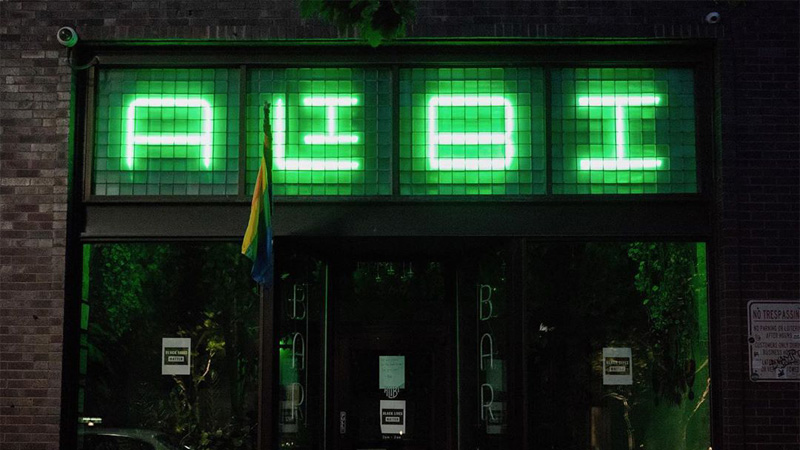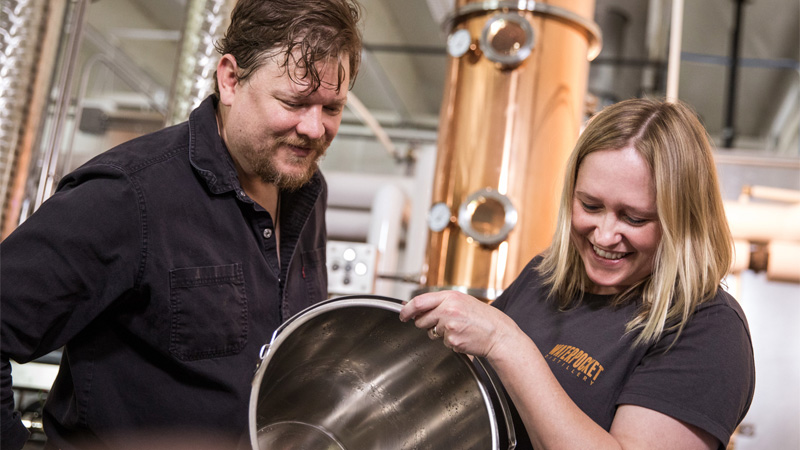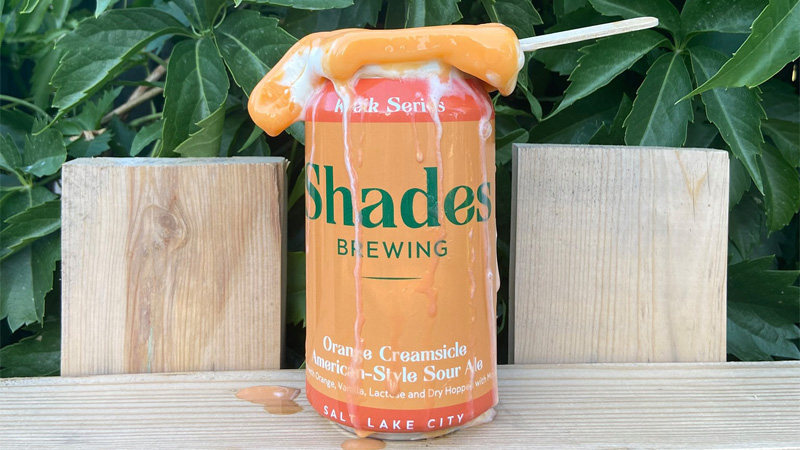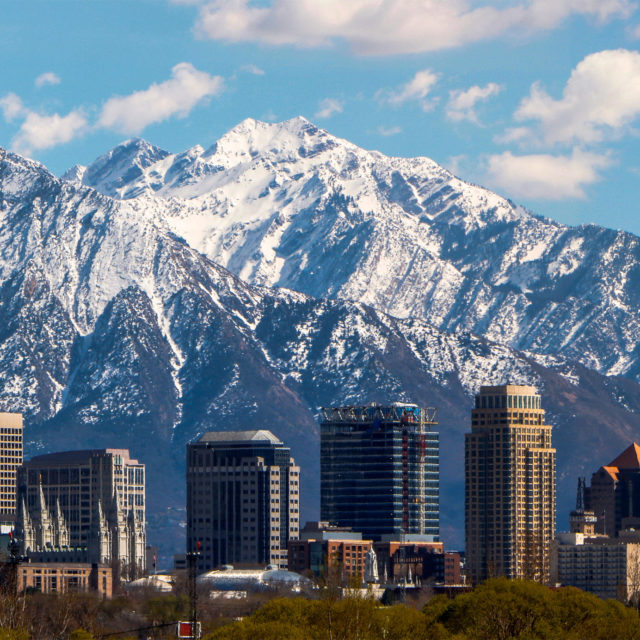Last fall, before Covid-19 swept in and changed everything, I found myself on a road trip through Utah that started in Salt Lake City. There, men dressed in white refused me entrance to the members-only temple of the Church of Jesus Christ of Latter-day Saints, but the state’s capital was full of revelations nonetheless. They were simply of the boozier kind — from a Suntori Toki highball laced with passionfruit and shiso at Post Office Place, a bar that claims the nation’s most Japanese whiskies, and clarified, hand-cut ice in a rye-and-Cynar elixir at buzzy eatery HSL, to a lithe Frapatto from Sicily’s tiny, organic Gurrieri winery, sipped for a song at the restaurant Table X, and local beers like the massive Pumpkin Imperial Stout from Epic Brewing and the salty Lake Effect gose from Proper Brewing.
Indeed, Salt Lake has come far from the days of 3.2 percent-ABV beer. Though hurdles erected by the state-run liquor board remain, the industry rolls with the punches here. Right now, with indoor service limited to six feet of social distancing between tables, many bars can’t afford to reopen at limited capacity, but there’s a #saveutahbars campaign afoot to push the state legislature to legalize takeout cocktails. It’s a group effort from a tight-knit community of creative pros who, in recent years, have been turning this booming town into the nation’s newest drinks hotspot.

New Millennium, New Attitude
In part, the energy comes from having something to prove. As Jacob Hall, a co-owner of the bar Alibi explains: “When you have such a religious state, you also have a strong counterculture. People want to show that the Utah stereotype is incorrect, and with that, you see a strong bar scene.”
At Alibi, which re-opened on July 1 after three-and-a-half months closed, Hall squeezes grapefruit and yuzu together for his popular mezcal Palomas. Nine years ago, a typical Utah kid, he “didn’t know a damned thing about liquor,” he says. Then he landed a bar-back gig at Bar X, owned by “Modern Family” star Ty Burrell.
In 2010, the actor had rehabbed an Art Deco watering hole and filled it with spirits, testing would-be bartenders on 100 classic drinks. During the coronavirus shutdown, he’s shown leadership by launching a Tip Your Server fundraising initiative that’s raised over half a million dollars for displaced bar and restaurant workers and hosting a weekly fresh-market pop-up for industry workers in Bar X’s parking lot.
Back when it opened, Bar X was Salt Lake’s first serious cocktailist. The city was already transforming in those days, thanks to the 2002 Winter Olympics. “Pre-Olympics, you needed a private membership to get into bars,” recalls beverage writer Darby Doyle. “The bars had airplane-sized bottles, and you mixed your own drink. The Olympic planning committee was like, ‘You’ve got to be kidding if you think our people are going to come if the liquor laws aren’t normalized.’”
Regulations the state relaxed for the games couldn’t be re-tightened without an uproar. In 2009, the private-membership restriction was nixed. Since then, SLC’s drinks culture has boomed along with its economy. An influx of non-Mormon newcomers have been drawn to the area both by employers like Adobe and Goldman Sachs, and by a high quality of life centered on Utah’s outdoors. Lots of them want to drink.
Cocktails Take Off
With its wild artwork and backlit Japanese spirits to go with the Japanese-Peruvian bites, Post Office Place is the kind of bar you’d hope to find in any city — unique and delicious. Bartenders here, as elsewhere in Utah, have worked with restrictions: 1.5 ounces of base spirit allowed, plus an ounce of a flavoring spirit. But that hasn’t dampened their creativity. A rye-and-reposado Tom Kha Sour amped up with lemongrass, tamarind, ginger, and fish sauce? Yes, please.
How do you sell a drink like that to a city still new to cocktails?
“By explaining to people and holding their hands,” says Crystal Daniels, general manager at Post Office Place. That level of service speaks to the scene’s warm vibe. If you’re going to push the town to drink, you gotta do it gently. Right now, with their small space still shuttered, Daniels and crew have been batching out bottled mixers to sell from their sister restaurant, Takashi, next door: Watermelon Paloma; Playa Tamarindo with grilled lemon and pineapple; honey, sage, and yuzu Hachi Hive. Each comes with simple instructions for preparing the cocktail at home.
Even a bar star like Scott Gardner keeps things friendly. Gardner built programs at restaurants until 2016, when he launched Water Witch. It’s been a destination for Mexican drinks in jicara gourds and highballs with house-clarified grapefruit cordial, as well as a Miller Lite and shot. “We look at drinks like food: What is the mirepoix of a cocktail?” says Gardner. “But no matter how serious we get, everything needs to be fun. We’re not just fancy cocktail guys. We’re focused on community.”
Gardner and his partners are planning an August reopening for their bar, whose “Cheers”-like vibe is refreshing to visitors from a tougher market like New York. It also helped make the roulette option popular in SLC. A bartender chats with a customer, then creates a drink gauged to their preferences. At chic Under Current, reopened since May 12, the offering is called “Walk the Plank,” and it helps make the city’s beefiest classic cocktail list less intimidating. “It’s something people love,” says manager Natalie Hamilton. “I’ve seen a lot more trust in bartenders in the last few years.”
Alibi takes the trust further, partnering with a local rape recovery center on fundraising and anti-violence training for the drinks industry. Sensitivity is built into the look of the place. “The level of sexism Utah has is disturbing, and bars can be scary, mainly for women,” says Hill. “We designed ours to be open, with lots of colors and no dark areas. The bartender can see the whole floor and monitor things.”
It’s part of the larger mission to make every Utahn comfortable with drinking — even if they’re sober. Given the Mormon influence, spirit-free cocktails are serious here. Just try the blood orange-coconut-vanilla refresher at HSL or the beet cream soda at Table X. “We want to welcome anybody,” says Mike Blocher, a chef and co-owner of Table X, “whoever you are and whatever you believe in.”
That’s been clear across the Salt Lake City drinking scene since the May 25 murder of George Floyd prompted Black Lives Matter protests here. Though business was even further hampered by a weeklong curfew in response to the demonstrations, Table X and many other restaurants and bars have contributed prizes to an #SLCdrawingforBlackLives to support the movement.

Back to the Stills
A driver of the bar scene has been the advent of local distilling. High West installed Utah’s first post-Prohibition stills in 2006. Today, the Utah Spirit Trail lists nine stillhouses in Salt Lake County. The barrel-aged gin I enjoyed at HSL, blended with strawberry-cucumber simple syrup and St. Germain, came from Beehive, Utah’s first gin distillery since 1870.
Beehive has a full liquor license, so when the bar is open, guests can get a Spanish-style G&T, but they can also sip a Lagavulin, graze small plates, and enjoy the DJ. That kind of entertainment has helped SLC thrive. “The distilling and bar scene has helped lift perceptions,” says Erik Ostling, a co-owner of Beehive. “People come to Utah to hike, bike, and ski in the mountains. Now there is a viable nightlife, and we’ve been seeing people come to town to see what’s going on.”
For now, as the pandemic caseload increases in Salt Lake City, Beehive is keeping its bar closed, but the distillery’s shop is an official state liquor store, so patrons can still score Beehive spirits, craft mixers, local beers, and cocktails canned under the outfit’s Desolation Distilling label.
The most interesting distilling, though, is happening in a suburb just outside Salt Lake City at the Waterpocket, where Julia and Alan Scott produce maverick amaros and liqueurs from historic recipes. With Covid-19, they’re running a timed pre-order system for customer pickups of bottles like the turmeric-enriched Notom amaro and the orange, cake spice, and sage-infused Oread concocted from a 19th-century Danzig recipe. But when tours and tastings resume, visitors will sample the wares behind a wall called a Zion Curtain. Meant to protect minors from seeing drinks poured, the Zion Curtain was removed from bars in 2017, replaced with a 10-foot-wide “adults-only” zone. Waterpocket isn’t configured for such a setup, so the Zion Curtain remains. Luckily, bartenders pour their liqueurs in the open all over town.
Beer Town
In post-industrial neighborhoods, changes to zoning laws have given distillers space to make booze. They can thank brewers like Trent Fargher for that. At Shades Brewing in an old hot dog factory in South Salt Lake, his team ferments fruity yet dry sours with a proprietary strain of an old Norwegian yeast called kveik.
“We worked with city council to create a manufacturing license to allow for a taproom on premises,” says Fargher. “Now we have three breweries and three distilleries within walking distance.” He’s just installed a new beer garden out back for socially distanced drinking.
A few blocks north is another brewing center, in the historic grain warehouse district called The Granary. In a trio of former auto shops flooded with natural light, visitors sip German-style beers at Templin Family Brewing, whose taproom reopened on Memorial Day. Though taps can’t flow with anything over 5 percent ABV, cans and bottles get stronger. Templin Family makes 10.2 percent Trippel for a crowd that supports an abundance of brewers.
“I’ve been brewing in Salt Lake since 1995 when there were only four breweries. Today there are about 45,” says owner and brewmaster Kevin Templin. “Kids are coming in with new ideas and wild creativeness.”
Some of SLC’s other top breweries include Kiitos Brewing, where the stout is made with organic toasted coconut and the cream ale with locally roasted coffee beans; Fisher Brewing Company, which has reprised an 1884 family-owned label; and Proper Brewing Company, which produces an herb-brewed dubbel gruit — all are walking distance from Templin Family, making for an epic beer crawl. All of their stores are open for takeout during coronavirus times, and Proper’s taproom is pouring.

Wine Finds
The biggest discoveries, though, are on SLC’s wine lists. To understand why the restaurant Pago offers a tiny-production Alepa Riccio Bianco 2013, made from Campania’s ancient Pallagrello Bianco grape, for not much more than the retail price, you have to understand Utah’s liquor laws.
Restaurateurs here can’t get discounts or deliveries; they go to the state store for wine at retail price. BYOB-friendly laws combine with the system to keep markups low. “Consumers know what restaurants are paying, and if they mark up wine exorbitantly, people just bring their own,” explains Tracey Thompson, the president and CEO of the brokerage Vine Lore. “You can bring wine to a restaurant, and they will charge a reasonable corkage fee.”
Another advantage for enophiles is the reduced pricing for small producers. The state’s standard markup is 88 percent. For wineries making less than 20,000 gallons, it’s 49 percent. “If a product gets a high score in Wine Spectator, a retailer in another state might pop the price up 50 percent,” says Brad Jensen, the Utah-based president of Bon Vivant Imports. “Here, the price is the price, so you can find interesting things cheaper.” So an Olivier Leflaive Chassagne-Montrachet 2014, for example, might be $69 in a Utah state store, while it’s above $80 elsewhere.
And an organically farmed Quarta Generazione Aglianico del Vulture DOCG by a fourth-generation female winemaker in Basilicata? You’ll pay $33.99 for that at Salt Lake stores, and that’s the only place in the U.S. that you’ll find it because another boon for SLC wine drinkers is small, Utah-only importers.
One of them is Stephanie Cuadra, founder of Terrestoria. She brings in wines from tiny, organic Italian and Spanish producers. Many are special orders, meaning the liquor control board buys a bespoke case for any restaurant or consumer requesting it. For importers of the artisanal producers on the lists at Pago, Table X, HSL, and other restaurants, “Utah is a perfect fit,” she says. “If an importer has big markets, why bother with Utah? But traditional importers are also not paying attention to such small wineries. So the proportions are right.”
Wines found nowhere else sold at reasonable prices, fascinating cocktails in friendly bars, creative distilleries and breweries by the dozens — here’s a toast to you, Salt Lake City. Best of all, the scene is still young and ambitious. The pros still push themselves to bring drinkers inspiring sips.
“Salt Lake City is a cow town,” says Scott Gardner. “It always will be. People from outside come with not much expectation, and the lack of expectation makes it easy to succeed. But we tell our staff, ‘Don’t rest on your laurels. You have to keep grinding and staying on top.’”
